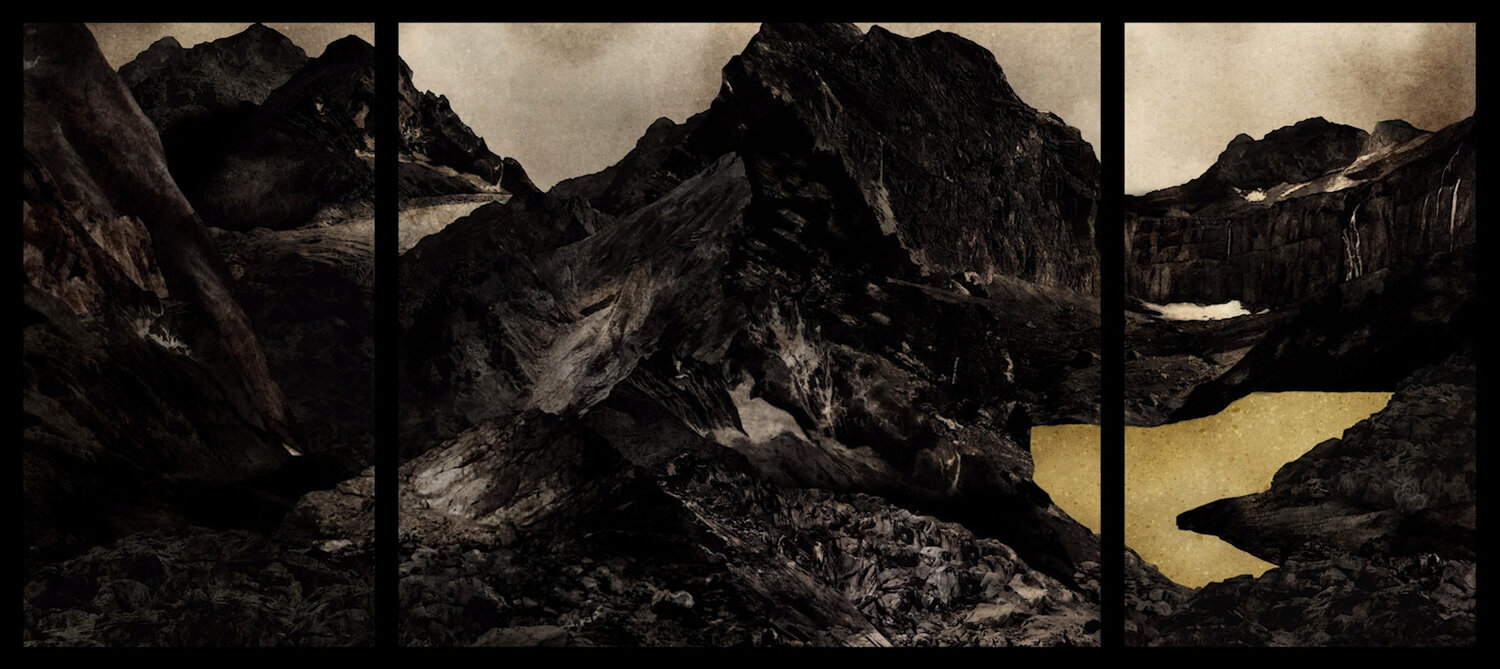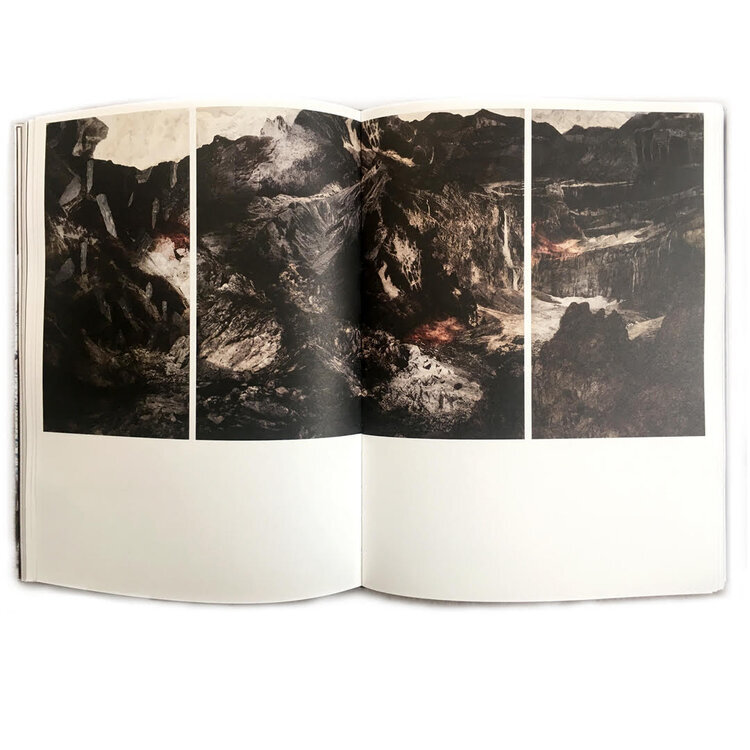
Vergine Keaton (b. 1981, France)
Guillaume Quéméré (b. 1981, France)
Vous qui entrez ici, 2019
Multi-channel video / 07:00 / loop / color / stereo
Steel, wood, technology / 4 screens / 1 computer / 1 sound system
248,6 x 112,2 x 12,4 cm / 4320 x 1920 px
Courtesy of the artists & Dalbin Gallery
About the work
Vergine Keaton’s digital altarpiece is a multi-channel video installation commissioned for the “Opera Monde” exhibition at Centre Pompidou – Metz.
From what nowhere exists, nothing can be born. And that being annihilated it is not possible or believable. Because it will always be where it has always been supported. This extract from the Fragments of Empedocles translates a principle peculiar to pre-socratic thought, according to which the world has nothing fixed, constant or finished, but is on the contrary perpetually animated by forces of creation and destruction, acting on the four elements of earth, water, fire and air. This is a cosmogenesis, a dramaturgy of terrestrial and celestial phenomena which also seems to be played out in this film, whose images are those of a universe in the making, crossed by movements a priori contrary but in reality complementary to the fusion and separation of matter particles. Dedicated to articulate, to disintegrate and to reassemble constantly in new configurations, this material consists of paintings, engravings and other documents that the artist scans, decomposes and recomposes into stratified landscapes and arranged in infinite transmutations.
Everything happens as if the world were governed by alternating forces of dissolution and aggregation of matter, as it is felt with You who enter here, whose title is borrowed from a sentence from Dante's Divine Comedy. From this story, the artist retains the principle of a world which seeks its own organization to achieve harmony, marking the passage from hell to paradise. Delimited by a triptych-shaped frame, a steep mountain landscape continues to renew itself, according to micro-movements forward and backward, right and left, according to rhythms and variable cadences, as under the pressure of geological forces eventually finding a homogeneous overall movement. In a way, this is a monistic vision of the world, according to which a priori opposite phenomena actually form a whole.
Watch the entire video
Duration: 07:00
Exhibitions
2020
”Utopic Landscapes” curated by Marie Maertens
Collector Series, Episode 1
w/ Pauline Bastard, Jean-Baptiste Bernadet, Karen Paulina Biswell, Andrea Blum, Brodbeck & de Barbuat, Elsa & Johanna, Niklas Goldbach, Terencio González, Ségolène Haehnsen Kan, Cui Jie, Vergine Keaton, Bharti Kher, Matthew Krishanu, Michèle Magema, Pedro Motta, Yu Nishimura, Constance Nouvel, Joseph Obanubi, Daniel Otero Torres, Neil Raitt, Louis-Cyprien Rials, Torben Ribe, Torbjørn Rødland, Ben Russell, Hrair Sarkissian, Trevor Shimizu, Chulayarnnon Siriphol, Patrick Tosani, Mak Ying Tung 2, Zhou Zixi.
2019-2020
“Opera Monde” curated by Stéphane Ghislain-Roussel
From June 22nd, 2019 to January 27th, 2020
Centre Pompidou, Metz, France
w/ Kasimir Malevitch, Bill Viola, James Turrell, William Kentridge, Vergine Keaton, David Hockney, Romeo Castellucci, Matthew Barney, Clément Cogitore, László Moholy-Nagy, Roland Topor, Dominique Gonzalez-Foerster, Ingmar Bergman, Oskar Kokoschka, Renzo Piano, Philippe Parreno, Philip Glass, Robert Wilson, Werner Herzog, Pier Paolo Pasolini, Federico Fellini, Pina Bausch, Richard Wagner...
For the first time on this scale, "Opera as the World" proposes a journey through the history of opera in the 20th and 21st centuries through the prism of its relationship with the visual arts. Far from a traditional reading and much more than a catalog devoted to opera set designs by artists, it intends to relate, in resonance with the heritage of the Wagnerian "Gesamtkunstwerk", how the visual arts and the lyrical genre have nourished each other and sometimes even radically influenced each other, from the early 20th century to the present day. In this back and forth movement, opera thus serves as a fertile ground for experimentation and as a catalyst for new aesthetic and political sensibilities. At a time of profound international socio-political upheavals and a questioning of the meaning and power of Europe, Opera as the World also explores and shows the political aura and the part of utopia that the lyrical genre conveys as a total work of art.
Credits
Visual Art: Vergine Keaton
Soundtrack: Guillaume Quéméré-Lantonnet
Technology: Paul Lacroix
Design & Production: Dalbin
Co-Production: Centre Pompidou – Metz and Sacrebleu
With the financial support of Région Grand-Est
Catalog
Opéra Monde - Exhibition catalog
Co-publishing: RMN-Grand Palais with Centre Pompidou Metz in partnership with the Paris Opera
EAN: 9782711874392
French language
320 pages / 244 illustrations
Press Excerpt
Télérama, 12/09/2019
Written by Sophie Bourdais
About the artist
© Photo by Heinrich Voekel
Vergine Keaton
Born in 1981, Paris, France
Lives and works in Paris, France
Vergine Keaton is a French visual artist and director who oscillates between experimental and animation films. After studying graphic design and cinema, Keaton’s first animated short film I was crying out at life. or for it (2009) screened at nearly 100 festivals including the ACID selection at Cannes Film Festival. Her following film Marzevan (2015), experimented with 3D mapping and was a short-list nominee in the category Best Short Animated Film at the 2017 César Awards in France. Her third film, The Tasmanian Tiger, was selected for the official competition for the 2018 Berlinale and screened at a number of international festivals.
Since 2016, she has been interested in installation. She develops projects on several screens, in various places, according to their architecture. Her works have been shown in Times Square NY, in the Pompidou Center in Metz, in FIAF Gallery - New York, in Multivision Erarta Museum of Contemporary Art - Saint Petersburg and in La Maison de la Poésie - Paris. She also teaches at ENSAD (National Higher School of Arts in Paris).
Vergine Keaton’s animations are based on pre-existing documents from classical and popular culture in which she draws details to create new shapes that are both familiar and unique. Her interest lies in the evocative potential of these images belonging to the collective memory and their ability to reinvent themselves.
In her films, no form is fixed or definitive. The matter is always moving, moving forward, retracting or opening. It builds the world in a cyclical movement: to unite / disunite.
Vergine Keaton is working on the deployment of the image and seeks to create a form of sharpness in repeating a small number of patterns, exhausting them until the detail becomes an event.
Visit her website: www.verginekeaton.net





